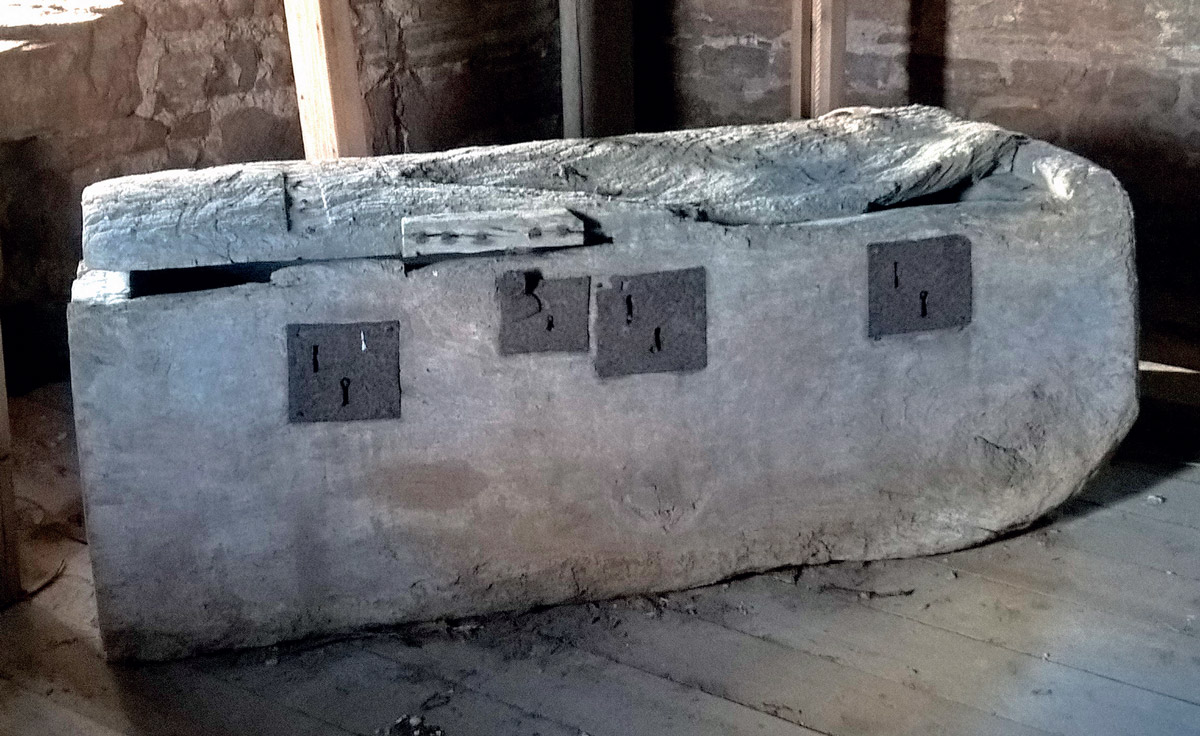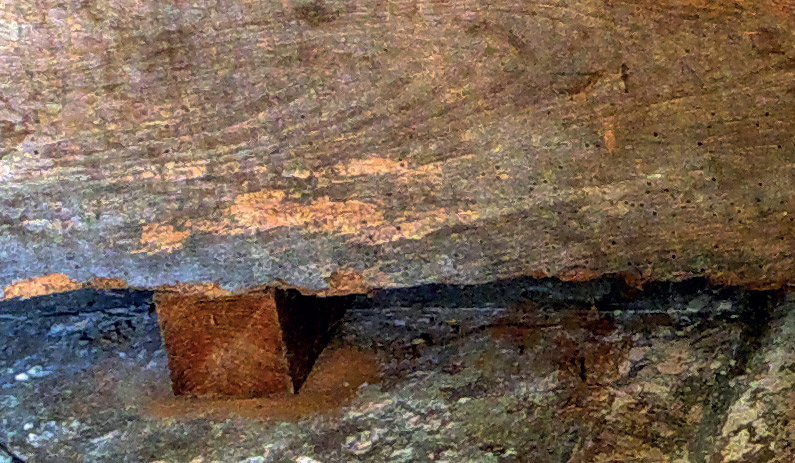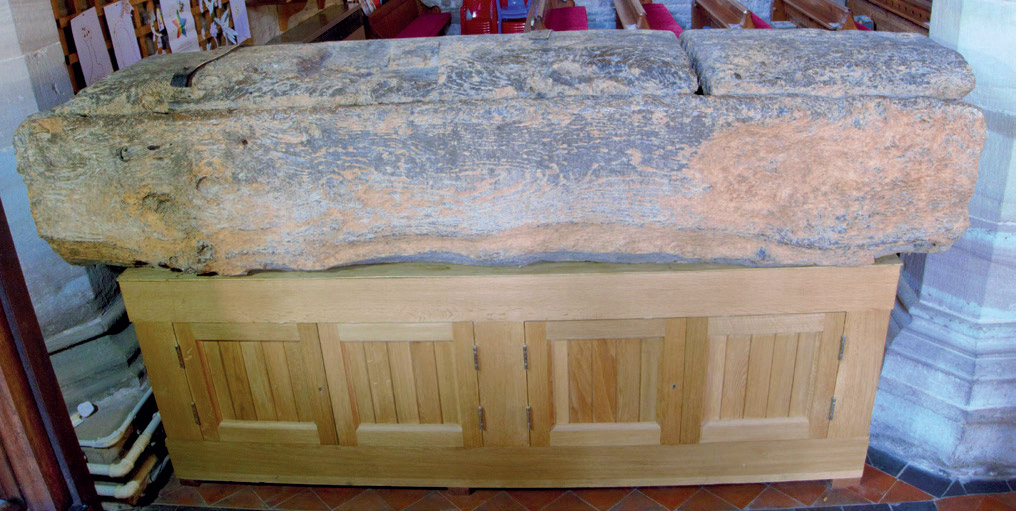Church Chests
Rachel Sycamore
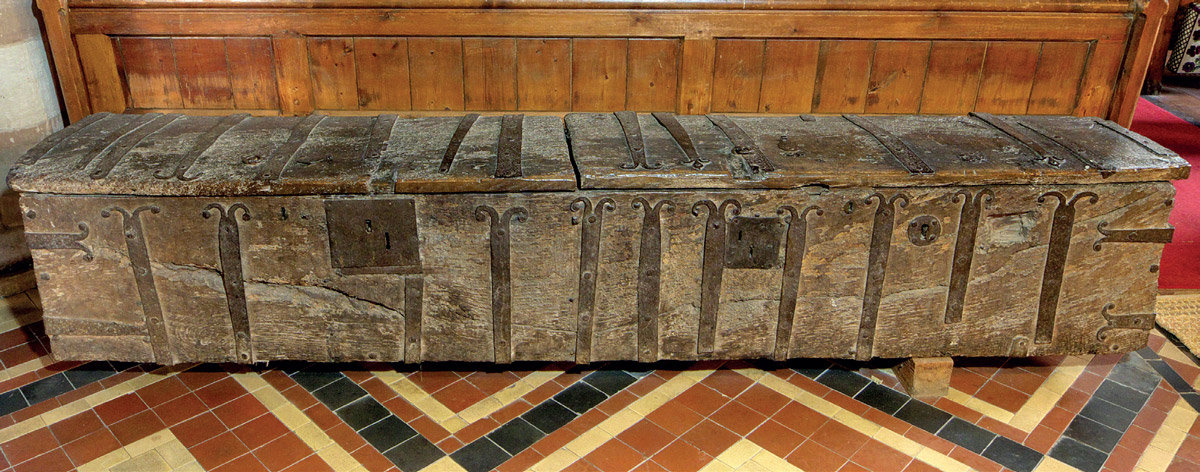
The 13th or early 14th century boarded chest at Cradley Church, Herefordshire
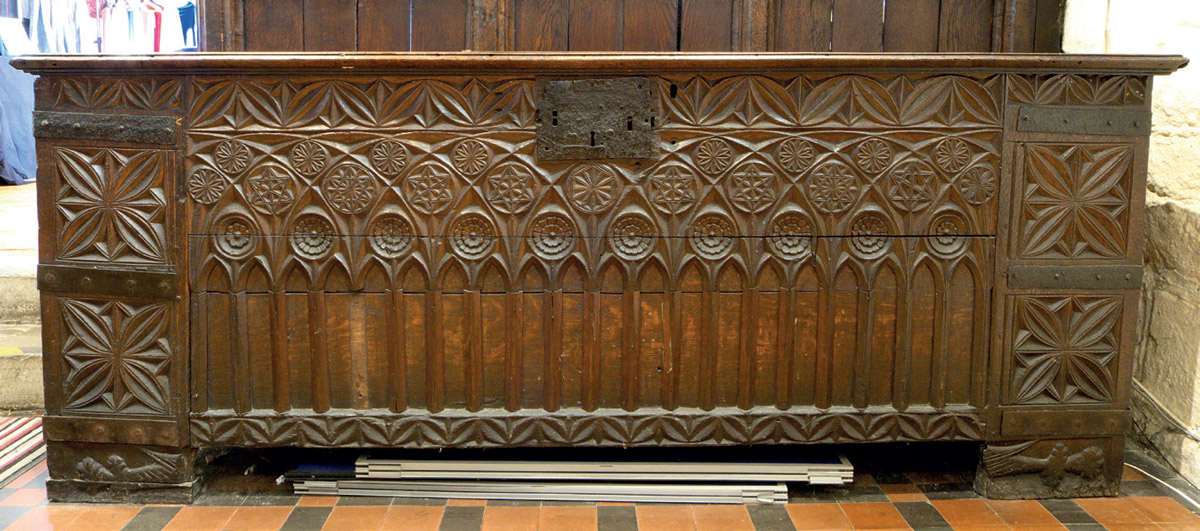 |
||
| The 14th century clamped chest at All Saints, Hereford, Herefordshire | ||
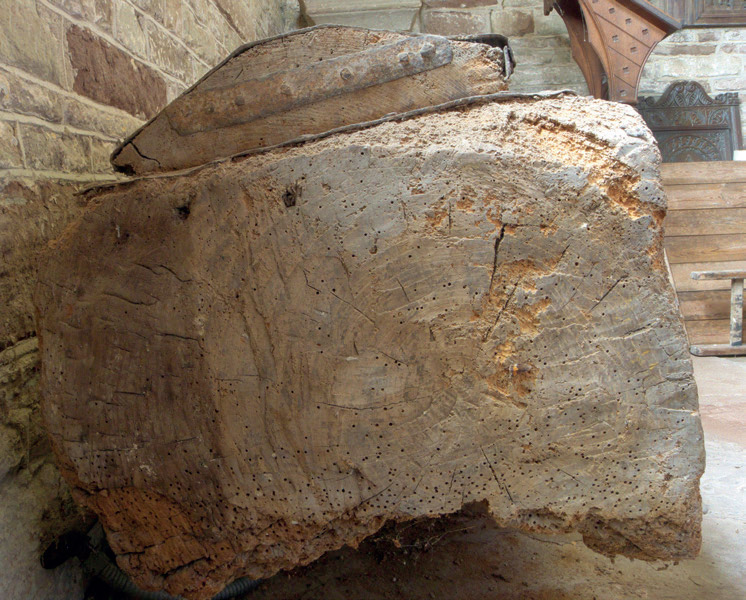 |
||
| The end of the 13th century dug-out chest at St Weonards Church, St Weonards, Herefordshire (All photos: Rachel Sycamore) |
Chests were amongst the most important and prevalent form of medieval furniture, and many still survive in parish churches today. Originally, they provided secure containers in which to store vestments, church plate, documents or alms for the poor, or to collect funds for crusades. Frequently made from oak or elm, sometimes pine or deal, they were constructed as heavy, immovable objects intended to keep their contents dry and secure from thieves and vermin.
There are four main types: dug-out chests made by hollowing out a solid tree trunk; boarded chests formed from six large boards nailed together; clamped chests so called because their fronts and backs comprise a large board (or boards) clamped between two wide stiles; and framed and panelled chests made from loose panels inserted within a frame to allow free movement of the wood. The latter appears in the 16th century to overcome the problem of shrinkage-splits. Some chests are a combination of two types; early studies assumed they evolved in sequence, but dendrochronology (tree-ring dating) has shown that different forms coexisted between the 13th and 16th centuries. It is therefore more likely that the choice of design was influenced by levels of skill, use, cost and preference.
During the medieval period the church chest underwent a process of transformation to comply with various edicts issued by kings and popes affecting their form, function, significance and even their physical position in the church. For example, in 1166, as penance for the murder of Thomas à Becket, King Henry II issued orders for ‘money trunks’ to be placed near the altar to collect relief for the Holy Land. They were to be fastened with three locks and three keys: one for the bishop, one for the priest and one for a religious layman, who each had to be present to unlock the chest. Many chests had money slots cut into their lids and in return for contributing alms, parishioners would be granted remission for their sins. A further edict in 1287, issued by the Synod of Exeter, ordered chests for the storage of books and vestments in churches but banned their use for the collection of money for crusades, and so existing money slots were covered up.
Since many chests held sacred items of church accoutrements, they too were made sacrosanct; this explains why they originally stood next to the altar, the most sacred part of the church. During the Reformation, many church chests and their contents were destroyed or sold to raise money for the crown, but some chests, particularly those in rural or remote areas, escaped destruction and remain in parish churches to this day. Some were gallantly hidden in crypts, belfries, or even streams.
The weatherworn dug-out chest at Foy Church in Herefordshire lies hidden from view in the belfry, open to the elements (illustrated below). It is believed to have been hidden here from Oliver Cromwell’s men during the Commonwealth, but as the only way up to the chest is via a very narrow spiral staircase, the chest must have been hoisted up into the belfry prior to the present flooring being fitted.
CONSERVATION ISSUES AND CONCERNS
Many churchwardens and members of the congregation face a challenge as to how to look after the legacy of the church chest. Often chests have been relocated to the rear of the church (if they can be moved) and used to store flower-arranging equipment, vases and Christmas decorations. Many have water-stains on their lids, broken hinges and missing locks, and often they contain mice droppings, decaying fabric and dust.
As part of research for an MRes in Medieval Archaeology, a total of 132 church chests in Herefordshire and 78 church chests in Worcestershire have been systematically recorded by the author. Around half were found to be poorly looked after and timber decay was prevalent: one churchwarden stated that the woodworm ‘come and go’ as though the chest would go on for many years to come. Sadly, this is not the case. Furniture beetle grubs live inside the timber, chomping away unseen for anything up to five years, before pupating and hatching just below the surface, emerging from their flight holes as little brown beetles. These have a few days to mate and lay their eggs, often in old flight holes. So continues the cycle until there is no nutrition remaining in the wood and it is reduced to a crumbling mass of dry ‘honeycomb’.
Woodworm favours sapwood, the timber just below the bark of the tree, but it will also attack heartwood if the conditions are right. Generally, relative humidity levels of around 60 per cent are required for the eggs to hatch and for pupation to occur. In a house or office environment it is almost always possible to reduce moisture movement to ensure that relative humidity never reaches these levels, however, this may be difficult in a church and if a chest is to remain in a damp environment the only recourse may be a proprietary chemical treatment to break the cycle and protect the timber from further decay.
Tell-tale signs of active woodworm include piles of gritty crumbs (frass; the regurgitated wood from the beetles) on the floor beneath the chest (see illustration), and flight holes which appear brighter in colour where pupa have recently emerged, with bits of frass beneath.
A further common ailment of the church chest is that of the ironwork becoming detached and lost. It is important that any ironwork which becomes loose or breaks away from the chest is kept in a safe place, preferably with labelling as to where it came from and when it came loose. Only a specialist conservation blacksmith should be consulted in the re-fitting or remaking of any replacement ironwork (see Commissioning Conservation Work from Blacksmiths, NHIG.org.uk); modern repairs should be obvious and always catalogued. The same is true for any necessary repairs to woodwork. Filler may be suitable for joinery which has been planed and painted, but on the aged wood of a church chest, wood filler of any type would appear unsightly and incongruous. Damaged timber that has lost its structural qualities should be carefully repaired with patches of the same timber, where old timber is carefully cut away and new timber inserted and colour-matched but remaining an obvious repair (illustrated above).
The massive dug-out chest in the north chapel at St Weonards measures almost 2.6m long by 610mm wide and 580mm high, and its length is divided into two sections of similar size, each with its own lid. It is one of the largest chests in Herefordshire, and one of the few made of elm. Sadly, it has suffered badly from both furniture beetle and death watch beetle attacks which caused much erosion to the ends and underside of the chest, where there is now a hole. One of the strap hinges on the left lid is broken and two of the locks on the right-hand half are missing. The chest stands on flagstones against two damp stone walls (illustrated on page 37) and there is little room for air circulation.
By contrast, the Eckington dug-out chest is comparatively small, measuring only 870mm long, 540mm wide and 520mm high. It is hewn from a trunk of elm, has one lid and one small cavity which was likely made for a bible or important church documents. The lid sits flush on the top of the base, with no rebate. Upon examination of the end-grain of the chest, it is apparent that the lid has been formed from a slice taken from the same trunk and the cavity displays the marks of the adze used to hollow it. Sadly, the chest has suffered considerable erosion from furniture beetle. Some of the lid has crumbled away at the edges, along with some of the underside of the chest. It has been suggested that the chest was buried at some point, or deliberately sunk into a river to protect its contents from Cromwell’s men. Unfortunately, two of the hasp fittings have been re-secured in place with wood filler rather than new timber being carefully inserted.
A good example of caring for a chest can be seen at Fownhope, Herefordshire. Here the enormous dug-out chest (illustrated on opposite page) has been brought down from the belfry and is displayed on a specially-made plinth, which not only facilitates the flow of air around the chest but also brings it to the eye level of a viewer. There can be no doubt that the congregation at Fownhope fully appreciates its importance.
CONSERVATION GUIDELINES
Minimum requirements for the conservation of church chests should include:
- Raising the chest up from the ground on wooden bearers or feet
- Allowing a good airflow around the whole chest, including the underside
- Regular, gentle removal of debris and dust from surfaces inside and outside
- Placing the chest away from damp stone walls and from direct sources of heat as movement caused by frequent changes of temperature can be damaging
- Where fresh frass indicates active furniture beetle or death watch beetle, an insecticidal wood preserver may be applied by brush, injected into flight holes, or in some cases sprayed into difficult areas (this requires appropriate safety procedures)
- Seeking the advice of the quinquennial inspecting architect/surveyor on the relative humidity levels of the environment surrounding the chest and on how to keep them below 60 per cent to reduce the likelihood of furniture beetle attack
- Recording and carefully storing any broken parts, documenting any restoration of the chest
- Employing a qualified conservator (a blacksmith or furniture restorer) to make sympathetic repairs or advise on caring for the finish of a chest.
One of the chests surveyed was found to have been coated with a coloured liquid brush-on wax, while another had been coated in a polyurethane varnish. In the hands of a conservator, microcrystalline waxes can protect old timber and metal surfaces without changing their appearance, but household cleaning products, aerosol polishes and other finishes should never be used. Some types of wax can harden to leave white dry residue in the cracks and crevices, while any varnish will yellow over time and flake off in unsightly pieces. Modern finishes may also be difficult to remove, so some damage may be permanent.
A micro-crystalline wax or non-yellowing oil mix can be carefully applied to both the ironwork and the timber, but each chest should be assessed individually by a conservator and any treatment should be in accordance with their advice.
THE FUTURE OF THE CHURCH CHEST
From carpenters to laymen, churchwardens to bishops, the church chest held various meanings for people throughout the medieval period. Given that many are consigned to the rear of the church and consistently overlooked, they now hold a very different meaning. It is time church chests received recognition for not only the workmanship that went into creating them, but also their significance as part of the archaeology of the church. An awareness of the importance and significance of the church chest should ensure that they are cared for in a way that will preserve them for future generations.
Further Information
Eames P ‘Furniture in England, France and the Netherlands from the 12th to the 15th century’, Furniture History, 13, pp 131–303 (1977), available at
www.jstor.org/stable/23404068
Geddes J, Medieval decorative ironwork in England, The Society of Antiquaries of London, 1999
Lewer HW and Wall JC, The church chests of Essex, Talbot & Co, London 1913
Morgan FC ‘Church chests of Herefordshire’, Woolhope Naturalists’ Field Club, pp 122–143 (1947)
Pickvance C ‘The Canterbury group of arcaded Gothic early medieval chests: a dendrochronological and comparative study’, The Antiquaries Journal, 98, pp 149–185 (2018)
Sherlock D (2008) Suffolk church chests, Suffolk Institute of Archaeology and History



